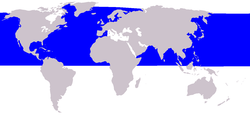Minke Whale
|
|
| Minke Whale Conservation status: Lower risk | ||||||||||||||||||
|---|---|---|---|---|---|---|---|---|---|---|---|---|---|---|---|---|---|---|
 A surfacing Minke Whale, SkjŠlfandi, Iceland | ||||||||||||||||||
| Scientific classification | ||||||||||||||||||
| ||||||||||||||||||
| Binomial name | ||||||||||||||||||
| Balaenoptera acutorostrata Lacepede, 1804 | ||||||||||||||||||
| Binomial name | ||||||||||||||||||
| Balaenoptera bonaerensis Burmeister, 1867 | ||||||||||||||||||
 Minke Whale range | ||||||||||||||||||
| Missing image Cetacea_range_map_Antarctic_Minke_Whale.PNG Antarctic Minke Whale range Antarctic Minke Whale range | ||||||||||||||||||
| Missing image Cetacea_range_map_Dwarf_Minke_Whale.PNG Dwarf Minke Whale range Dwarf Minke Whale range |
The Minke Whale or Lesser Rorqual is a marine mammal belonging to the suborder of baleen whales. The Minke Whale was first identified by Lacepede in 1804. Some modern classifications split the Minke Whale into two species; the Common or Northern Minke Whale (Balenoptera acutorostrata) and the Antarctic or Southern Minke Whale (Balaenoptera bonaerensis). Taxonomists further categorize the Common Minke Whale into two or three sub-species; the North Atlantic Minke Whale, the North Pacific Minke Whale and Dwarf Minke Whale. All Minke Whales are rorquals.
| Contents |
Physical characteristics
The Minke Whale is the second smallest of the baleen whales - only the Pygmy Right Whale is smaller. Male and female Minke Whales measure an average of 6.9 and 7.4 metres (22'8" to 24' 3") in length, respectively, at sexual maturity (6-8 years of age). Estimates of maximum length vary from 9.1m to 10.7m (19'10" to 35') for females and 8.8m to 9.8m (28' 10" to 32') for males. Both sexes typically weigh 4-5 tonnes at maturity, and the maximum weight may be as much as 14 tonnes. The gestation period for Minke Whales is 10 months and babies measure 2.4 to 2.8 metres (7'10" to 9'2") at birth. The newborns nurse for five months.
Minke Whales are distinguished from other whales by a white band on each flipper. The body is usually black or dark-grey above and white underneath. Most of the length of the back, including dorsal fin and blowholes, appears at once when the whale surfaces to breathe. The whale then breathes 3-5 times at short intervals before 'deep-diving' for 2-20 minutes. Deep dives are preceded by a pronounced arching of the back. The maximum swimming speed of minkes has been estimated at 20-30km/h. Minke Whales have between 240 and 360 baleen plates on each side of their mouths. Minkes typically live for 30-50 years; in some cases they may live for up to 60 years.
Population and distribution
The total population of Minke Whales is not known but is believed to be in the order of 150,000 in the North Atlantic, 25,000 in the North Pacific, and 750,000 in the Southern Ocean. Minke Whales are widely distributed throughout the world, commonly found from the poles to the tropics but prefer the open sea.
Whaling
Whaling was mentioned in Norwegian written sources as early as the year 800 and hunting Minke Whales with harpoons was common in the 11th century. In Western Norway, Minkes were trapped in bays and coves and killed with the help of bacteria infected arrows, a form of whaling that continued up until the 20th century.
By the end of the 1930s they were the target of coastal whaling from countries including Brazil, Canada, China Greenland, Japan Korea, Norway and South Africa. Minke Whales were not then regularly hunted by the large-scale whaling operations in the Southern Ocean on account of their relatively small size. However, by the early 1970s, following the over-hunting of larger whales such as the Sei, Fin, and Blue Whales, Minkes attracted the attention of these whalers too. By 1979 the Minke was the only whale caught by Southern Ocean fleets. Hunting continued apace until the general moratorium on whaling was introduced in 1986. According to a study by the International Whaling Commission, 116,568 Minke Whales were caught by whalers between 1904 and 2000. Around 100,000 of these were killed in the Southern Ocean.
Following the moratorium, most hunting of Minke Whales ceased. Japan and more recently Iceland (in August 2003) have continued hunting for Minkes on scientific grounds, however, these "scientific grounds " are criticised by many organisations as being a cover for commercial whaling. Both Iceland and Japan have the long term goal of resuming open commercial whaling. Although Norway initially followed the moratorium, they placed an objection to it with the IWC and resumed a commercial hunt in 1993. Norwegian whalers caught 217 Minkes in 1995 and 388 in 1996. The quota for 2004 has been set at 670 animals.
Minke Whale-watching
On account of their relative abundance Minke Whales are often the focus of whale-watching cruises setting sail from, for instance, the Isle of Mull in Scotland and HķsavŪk in Iceland. Minke Whales are frequently inquisitive and will indulge in 'human-watching'. In constrast to the spectacularly acrobatic Humpback Whale, minkes do not raise their fluke out of the water when diving and are less likely to breach (jump clear of the sea surface). This, combined with the fact that minkes can dive under water for as long as twenty minutes, has led some whale-watching enthusiasts to label them 'stinky minkes'. The name may also be applied because it is frequently possible to smell the breath of a Minke Whale whilst observing it from a boat.
References
- Minke Whales, Rus Hoelzel and Jonathon Stern, ISBN 1900455757
- National Audubon Society Guide to Marine Mammals of the World, Reeves, Stewart, Clapham and Powell, ISBN 0375411410
- Whale Watching in Iceland, Asbjorn Bjorgvinsson and Helmut Lugmayr, ISBN 9979761555
- Whales & Dolphins Guide to the Biology and Behaviour of Cetaceans, Maurizio Wurtz and Nadia Repetto. ISBN 1840370432
- Encyclopedia of Marine Mammals, editors Perrin, Wursig and Thewissen, ISBN 0125513402
- Odin Norwegian Ministry of Foreign Affairsda:VŚgehval
